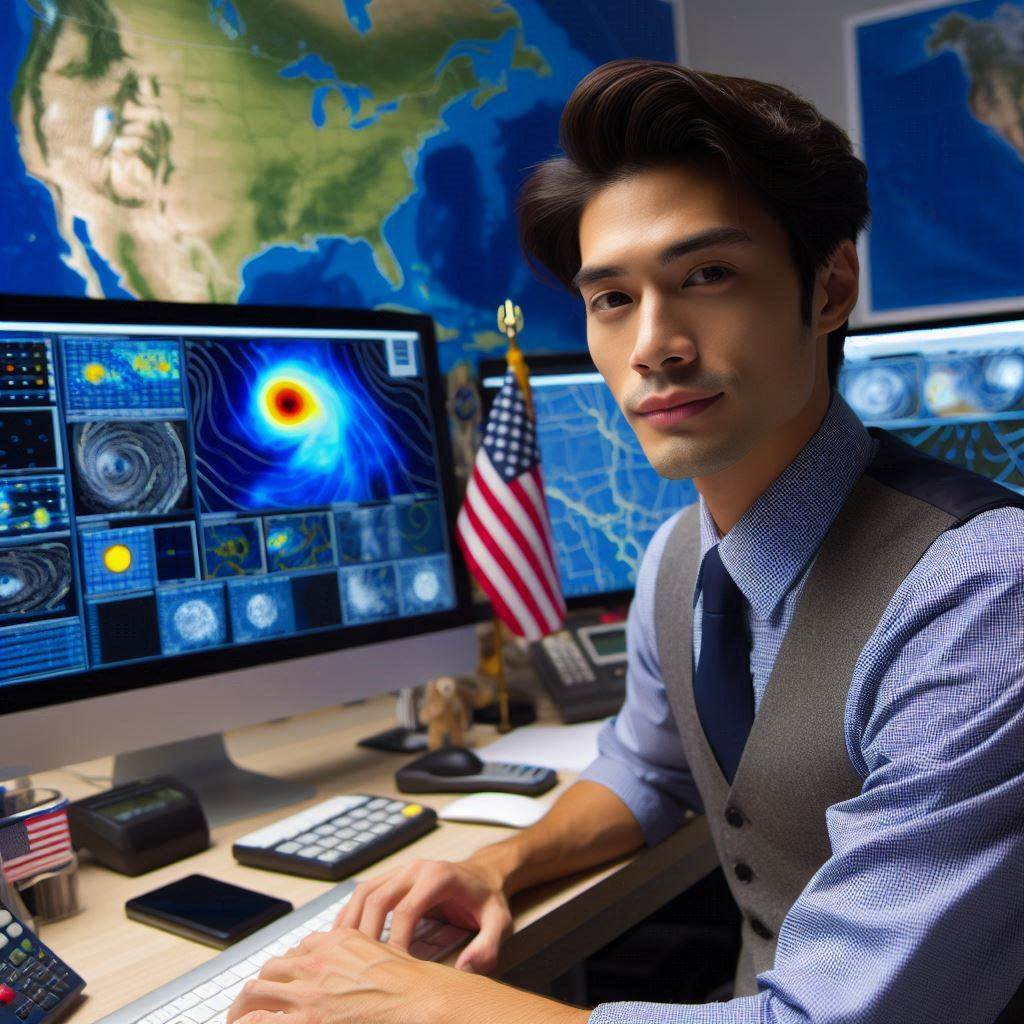Introduction
Meteorology is the scientific study of the atmosphere and its processes, with a primary focus on understanding and predicting weather patterns.
It involves examining various atmospheric conditions such as temperature, humidity, wind, and pressure, which all influence the weather we experience daily.
Meteorologists study these variables using advanced technology, data analysis, and mathematical models to better understand how the atmosphere behaves and changes over time.
Meteorology is a multidisciplinary field that draws on physics, chemistry, environmental science, and geography to form comprehensive weather predictions and climate models.
The importance of meteorologists in modern society cannot be overstated.
They play a critical role in understanding how weather systems develop and behave, which is essential for predicting both short-term weather conditions and long-term climate trends.
Accurate weather forecasts provided by meteorologists help individuals, communities, and governments prepare for routine weather as well as extreme events like hurricanes, tornadoes, and floods.
In fact, timely warnings from meteorologists often save lives and prevent significant property damage by allowing for evacuations and emergency planning.
Meteorologists are also crucial to industries such as agriculture, aviation, and transportation, where weather plays a major role in operations.
Farmers rely on weather forecasts to plan planting and harvesting, while airlines use meteorological data to ensure safe flight routes.
Shipping and logistics companies depend on weather predictions to prevent delays and optimize routes, and energy companies monitor weather patterns to anticipate energy demand, especially during extreme conditions.
Early Pioneers in Meteorology
The field of meteorology has evolved significantly over the centuries.
Early pioneers laid the groundwork for understanding weather patterns.
Among them, John Dalton, Luke Howard, and Robert FitzRoy made remarkable contributions.
Their work helped shape modern meteorology.
Contributions of John Dalton and His Atomic Theory to the Study of Weather
John Dalton was a pivotal figure in early meteorology.
He introduced the atomic theory, which revolutionized how we understand gases.
Dalton‘s theory explained how different gases interact in the atmosphere.
He proposed that air consists of various gases, each with unique properties.
This understanding was crucial for studying weather phenomena.
Dalton‘s ideas provided a foundation for later scientists to build upon.
His work on gas laws directly influenced meteorological studies.
Work of Luke Howard in Classifying Clouds
Luke Howard made significant contributions to cloud classification.
In 1803, he published a groundbreaking essay titled “On the Modifications of Clouds.
” Howard identified and named cloud types, such as cirrus, cumulus, and stratus.
His systematic approach to classifying clouds greatly advanced meteorology.
By categorizing clouds, Howard helped meteorologists link cloud types to weather patterns.
His work made it easier to predict weather based on observed clouds.
This classification system remains fundamental to meteorology today.
Impact of Robert FitzRoy’s Weather Forecasting Techniques
Robert FitzRoy was instrumental in developing weather forecasting techniques.
As captain of the HMS Beagle, he collected extensive meteorological data during voyages.
FitzRoy pioneered the use of barometers to predict storms.
His emphasis on systematic observations improved forecasting accuracy.
He established the first weather service in Britain in 1854.
This service provided daily weather reports to the public.
FitzRoy‘s methods laid the groundwork for modern meteorological practices.
His innovative approaches helped save lives during severe weather events.
The contributions of these early pioneers were monumental.
Dalton‘s atomic theory enhanced our understanding of atmospheric gases.
Howard‘s cloud classification system streamlined the prediction of weather patterns.
FitzRoy‘s techniques advanced the field of weather forecasting.
Together, they transformed meteorology into a scientific discipline.
Their work remains influential in modern meteorological practices.
Read: The Future of Botany: Emerging Fields and Innovations
Famous Meteorologists from the Past Century
Meteorology has seen significant advancements in the past century, largely due to the contributions of prominent scientists.
Among these figures are Dr. Theodore Fujita, Joanne Simpson, and Ed Lorenz.
Their research and findings have profoundly impacted weather science and forecasting.
Dr. Theodore Fujita and His Research on Tornados
Dr. Theodore Fujita was a renowned meteorologist known for his groundbreaking research on tornadoes.
He developed the Fujita Scale in 1971, which classifies tornadoes based on their intensity and damage.
This scale helped scientists assess tornado strength and improve public safety measures.
Fujita’s detailed studies of tornado behavior led to a better understanding of their formation and paths.
He conducted extensive field research, analyzing damage patterns after tornadoes struck.
His work revolutionized tornado research and enhanced forecasting techniques, ultimately saving lives.
Joanne Simpson, the First Woman to Receive a PhD in Meteorology
Joanne Simpson broke barriers in meteorology as the first woman to earn a PhD in the field.
She completed her doctorate at the University of Chicago in 1949.
Simpson’s research focused on cloud physics and tropical meteorology.
Her pioneering work significantly advanced the understanding of hurricane formation and behavior.
She published numerous influential papers throughout her career, contributing to the scientific community.
Simpson‘s achievements inspired many women to pursue careers in meteorology.
Her legacy continues to influence future generations of meteorologists.
Contributions of Ed Lorenz to Chaos Theory and Weather Prediction
Ed Lorenz is famous for his contributions to chaos theory and its implications for weather prediction.
In the 1960s, he discovered that small changes in initial conditions could lead to vastly different weather outcomes.
This finding, often summarized as the “butterfly effect,” demonstrated the inherent unpredictability of weather systems.
Lorenz’s work emphasized the limitations of traditional weather forecasting methods.
He developed mathematical models to simulate atmospheric behavior, improving forecasting accuracy.
His insights have shaped modern meteorology and contributed to understanding complex systems.
The contributions of these famous meteorologists have significantly impacted the field.
Dr. Theodore Fujita’s tornado research enhanced safety measures and forecasting.
Joanne Simpson’s groundbreaking achievements paved the way for women in science.
Ed Lorenz‘s chaos theory reshaped our understanding of weather prediction.
Together, their work has transformed meteorology into a dynamic and evolving science.
Meteorologists and Climate Change
Meteorology plays a crucial role in understanding climate change and its effects on the planet.
Several prominent meteorologists have made significant contributions to this field.
Notable figures include Dr. James Hansen, Dr. Katharine Hayhoe, and Dr. Michael Mann.
Their research and advocacy have advanced our understanding of climate science and its implications.
Dr. James Hansen and His Research on Global Warming
Dr. James Hansen is a leading climate scientist known for his pioneering research on global warming.
In the 1980s, he presented compelling evidence of human-induced climate change to Congress.
Hansen’s work focused on the impact of greenhouse gases on global temperatures.
He developed climate models that projected future warming scenarios, highlighting the urgency of addressing climate change.
His advocacy for climate action has made him a prominent voice in the climate movement.
Hansen‘s research has profoundly influenced public policy and raised awareness of climate issues.
Dr. Katharine Hayhoe and Her Work on Communicating Climate Science
Dr. Katharine Hayhoe is renowned for her efforts in communicating climate science effectively.
She combines her expertise in atmospheric science with a passion for outreach.
Hayhoe focuses on bridging the gap between scientific understanding and public perception.
She emphasizes the importance of relatable messaging about climate change.
Through her work, she aims to engage diverse audiences and foster climate action.
Hayhoe has contributed to numerous reports and publications, emphasizing the urgency of addressing climate issues.
Her efforts have made climate science more accessible and relatable to the general public.
Dr. Michael Mann’s Research on Climate Change and Extreme Weather Events
Dr. Michael Mann is famous for his research on climate change and extreme weather events.
He is known for developing the ‘hockey stick‘ graph, which illustrates rising global temperatures.
Mann’s work highlights the connection between climate change and an increase in extreme weather phenomena.
His research emphasizes the importance of understanding these connections for effective climate policy.
Mann advocates for transparent and honest communication about climate science.
He engages in public discourse, addressing misinformation and promoting climate literacy.
The contributions of these meteorologists have significantly shaped our understanding of climate change.
Firstly, Dr. James Hansen‘s research has been pivotal in raising awareness of global warming.
Dr. Katharine Hayhoe‘s communication strategies have made climate science accessible to broader audiences.
Dr. Michael Mann‘s work has underscored the link between climate change and extreme weather events.
Together, they continue to inspire action toward a more sustainable future.
Read: What Does a Geologist Do? Career Overview and Insights

Modern Experts in Meteorology
Modern meteorology benefits from the contributions of leading scientists who push the boundaries of research and advocacy.
Notable figures include Dr. Marshall Shepherd, Dr. Irene Colwill, and Dr. Jennifer Francis, whose work has significantly impacted atmospheric science and climate understanding.
Dr. Marshall Shepherd and His Advocacy for Science Communication
Dr. Marshall Shepherd is a renowned meteorologist known for his advocacy of science communication.
As a former president of the American Meteorological Society, he has focused on improving public understanding of weather and climate science.
Shepherd is also a leading voice in discussions about the intersection of weather, climate change, and social justice.
He emphasizes the need for clear communication between scientists and the public, breaking down complex topics for a broader audience.
Through his role as a professor and public speaker, Dr.
Shepherd actively educates the public about climate change and extreme weather events.
His efforts ensure that scientific findings are accessible to people outside the academic world.
Dr. Irene Colwill and Her Work on Atmospheric Chemistry
Dr. Irene Colwill is an influential expert in atmospheric chemistry, specializing in how chemical reactions in the atmosphere affect air quality and climate.
Her work examines the impact of human activities, such as industrial emissions, on atmospheric composition.
Colwill‘s research focuses on understanding how pollutants interact with natural atmospheric processes, leading to ozone depletion, acid rain, and greenhouse gas accumulation.
She has contributed to various international studies on air pollution and its effects on human health and the environment.
Colwill‘s findings are crucial for creating policies that target emissions reduction and improve global air quality.
Her work has advanced our understanding of the chemical dynamics that drive climate change.
Dr. Jennifer Francis and Her Research on Arctic Climate Change
Dr. Jennifer Francis is a leading researcher on Arctic climate change and its effects on global weather patterns.
She has been at the forefront of studying how Arctic warming influences the jet stream, contributing to extreme weather events such as cold spells and heatwaves.
Francis has brought attention to the “Arctic amplification” phenomenon, where the Arctic region warms at a faster rate than the rest of the planet.
Her research highlights the connection between the rapidly changing Arctic and unpredictable weather in temperate regions.
Francis‘s work underscores the urgency of addressing climate change, as the impacts of Arctic warming extend far beyond the polar region.
These modern experts in meteorology continue to shape the future of atmospheric science.
Firstly, Dr. Marshall Shepherd‘s commitment to science communication bridges the gap between research and public understanding.
Dr. Irene Colwill‘s work on atmospheric chemistry offers valuable insights into human impacts on the environment.
Dr. Jennifer Francis‘s research on Arctic climate change emphasizes the global consequences of polar warming.
Together, they contribute to a deeper understanding of our planet’s climate and inspire action to mitigate its challenges.
Transform Your Career Today
Unlock a personalized career strategy that drives real results. Get tailored advice and a roadmap designed just for you.
Start NowRead: Educational Path: Becoming a Geologist in the USA
Technology Advancements in Meteorology
Advancements in technology have dramatically transformed meteorology, enabling more accurate weather predictions and climate modeling.
Three key innovations‘satellites, Doppler radar, and supercomputers‘have played a crucial role in enhancing our ability to monitor, forecast, and understand weather and climate patterns.
Impact of Satellites on Weather Forecasting
Satellites have revolutionized weather forecasting by providing real-time, global observations of Earth‘s atmosphere.
Launched in the 1960s, meteorological satellites continuously capture images of cloud formations, ocean temperatures, and storm systems.
These images allow meteorologists to track weather patterns over large distances and improve forecast accuracy.
Satellites also monitor severe weather events, such as hurricanes, in their early stages.
This early detection provides valuable time for warnings and evacuation planning.
Additionally, satellites help monitor long-term climate changes, such as ice melt and rising sea levels.
Their comprehensive data has made weather forecasting faster and more reliable than ever.
Use of Doppler Radar in Predicting Severe Weather
Doppler radar technology has greatly improved the ability to predict severe weather, especially thunderstorms and tornadoes.
Introduced in the 1980s, Doppler radar detects the velocity and direction of precipitation in the atmosphere.
This allows meteorologists to measure wind speed and identify rotation in storm systems, a key indicator of potential tornadoes.
By analyzing these patterns, Doppler radar provides early warnings for severe weather, helping to reduce casualties and property damage.
It also aids in predicting hailstorms, flash floods, and other dangerous weather conditions.
Doppler radar has become an essential tool for weather stations and emergency response teams.
Role of Supercomputers in Modeling Climate Patterns
Supercomputers play a vital role in climate modeling and long-term weather forecasting.
With their immense processing power, supercomputers can analyze vast amounts of meteorological data to simulate climate patterns.
These simulations, known as models, allow scientists to predict future weather conditions and long-term climate changes with greater accuracy.
Supercomputers also improve the precision of short-term weather forecasts by processing complex atmospheric variables faster.
Climate models created by supercomputers help researchers understand how factors like greenhouse gas emissions and ocean temperatures will impact global weather patterns.
Supercomputers are crucial for advancing research on climate change and guiding policymakers on sustainable actions.
These technological advancements have transformed meteorology into a precise and data-driven science.
Satellites provide a global perspective on weather patterns and climate changes, Doppler radar enhances severe weather detection, and supercomputers enable sophisticated climate modeling.
Together, these innovations have vastly improved the accuracy of weather forecasts and deepened our understanding of Earth‘s atmosphere.
As technology continues to advance, meteorology will only become more powerful and essential for mitigating the impacts of extreme weather and climate change.
Read: Botany Career Fairs and Networking Events
Delve into the Subject: Technologies Transforming Neuroscience Research
Challenges Faced by Meteorologists Today
Meteorologists play a crucial role in forecasting weather and understanding climate change, but they face significant challenges in their work.
These challenges include dealing with climate change skepticism, balancing forecast accuracy and accessibility, and addressing the lack of diversity in the field.
Overcoming these obstacles is essential to advancing meteorology and improving public understanding of weather science.
Dealing with Climate Change Skepticism
One of the biggest challenges meteorologists face today is addressing climate change skepticism.
Despite overwhelming scientific evidence, some individuals and groups still deny or downplay the reality of human-caused climate change.
Meteorologists, as public-facing scientists, often encounter this skepticism in their work, particularly when presenting findings on rising global temperatures and extreme weather events.
This opposition can hinder efforts to promote climate action and influence public opinion.
Meteorologists must navigate these discussions carefully, relying on clear, evidence-based communication to dispel myths and inform the public.
Overcoming this challenge requires persistence in educating audiences and fostering trust in scientific research.
Balancing Accuracy and Accessibility in Weather Forecasts
Another challenge faced by meteorologists is balancing the need for accurate, detailed weather forecasts with making them accessible to the general public.
Scientific weather models can be complex and difficult to translate into simple language that non-experts can easily understand.
Meteorologists must communicate these predictions in a way that maintains scientific integrity while being easily digestible for a wide audience.
Inaccurate forecasts can damage public trust, while overly technical language can lead to confusion.
Striking the right balance is crucial for ensuring that people take weather warnings seriously and respond appropriately to impending weather events.
The Lack of Diversity in the Field of Meteorology
The field of meteorology has historically struggled with a lack of diversity, particularly in terms of gender and race.
This lack of representation limits the variety of perspectives and ideas within the field, which can stifle innovation and research.
Additionally, underrepresented groups may feel discouraged from pursuing careers in meteorology due to a lack of visible role models or support networks.
Addressing this challenge requires proactive efforts to promote diversity and inclusion through mentorship, outreach, and educational programs.
Increasing representation will not only enrich the field but also ensure that diverse communities have a voice in weather-related decision-making.
Meteorologists today must navigate complex challenges that extend beyond weather forecasting.
Dealing with climate change skepticism requires clear, fact-based communication to overcome misinformation.
Balancing forecast accuracy with accessibility ensures that crucial weather information reaches all audiences effectively.
Addressing the lack of diversity in meteorology opens the field to fresh ideas and perspectives, fostering innovation and growth.
As these challenges evolve, meteorologists must adapt, continuing their essential work in protecting and informing the public while advancing scientific knowledge.
Conclusion
Famous meteorologists have significantly shaped our understanding of weather patterns and atmospheric science.
Pioneers like John Dalton and William Ferrel laid foundational concepts that revolutionized meteorology.
Their groundbreaking research paved the way for modern experts like Dr.
Judith Curry and Dr. Eric Holthaus, who continue to advance meteorological science through innovative research and technology.
The contributions of both past and present meteorologists highlight the field’s evolving nature and importance.
Their dedication to understanding weather phenomena has improved forecasting accuracy and enhanced public safety during severe weather events.
The work of these trailblazers has not only influenced science but also positively impacted society, demonstrating the practical applications of meteorology.
Aspiring meteorologists should draw inspiration from these influential figures.
Embrace the spirit of innovation and curiosity that drives the field forward.
Explore new technologies, methodologies, and interdisciplinary approaches to enhance your skills and knowledge.
The field needs passionate individuals who can push boundaries and challenge existing norms.
By continuing this legacy of discovery, you can contribute to a safer, more informed world.
[E-Books for Sale]
The Big Book of 500 High-Paying Jobs in America: Unlock Your Earning Potential
$19.99 • 500 High-Paying Jobs • 330 pages
Explore 500 high-paying jobs in America and learn how to boost your career, earn more, and achieve success!
See All 500 High-Paying Jobs of this E-Book
1001 Professions Without a Degree: High-Paying American Jobs You Can Start Now
$19.99 • 1001 Professions Without a Degree • 174 pages
Discover 1001 high-paying jobs without a degree! Unlock career tips, skills, and success strategies for just $19.99!




